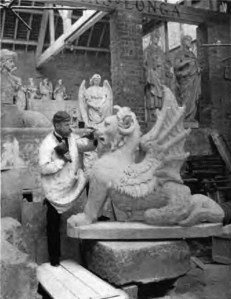Harry Hems, the Victorian woodcarver and stone master seen below in his workshop, and Jean Baudrillard, the French philosopher have seemingly nothing in common, except, perhaps, that they each engaged with the practice (Hems) and the theory (Baudrillard) of appearance.
In his influential ‘The Orders of Simulacra’, Baudrillard introduces three orders of appearance which have followed one another since the Renaissance:
- ‘Counterfeit is the dominant scheme of the “classical” period, from the Renaissance to the industrial revolution;
- Production is the dominant scheme of the industrial era;
- Simulation is the reigning scheme of the current phase that is controlled by the code’ (1983: 83)
For Baudrillard, ‘Counterfeit’ requires the presence of a unique original. Let’s take the example of Hems. He needed the original medieval objects which he used to inspire his workmen and even removed them from the places in which they were located into his workshop. We therefore assume that the medieval artefacts were ‘present’ in his workshop (though we cannot actually see them in the image above).
‘Production’ for Baudrillard is characterised by mass production and serial repetition. Uniqueness and origin are no longer ‘a matter of concern’ (1983: 96) and copies cannot be distinguished from one another. Hems did not operate industrially, but the potential of production is visible in the scale of his workshop, which at its peak, employed over 200 workers (though we cannot see them in the images above and below). So each of the medieval objects in RAMM’s possession may have led to the production of different artefacts. I don’t know, for example whether the restoration of a particular boss on Dartmoor generated only a work for that site, or whether designs were used in other sites and contexts. Hems worked all over England, and in the USA. Did the objects in RAMM’s possession, the ‘originals’, constitute the inspiration behind the development of some kind of Victorian-medievalist ‘prototype’? Furthermore, did anyone, inspired by Hems, then produce industrial models of these designs? How did these medieval bosses ‘migrate’ into the contemporary?
Finally ‘Simulation’ defines our age. There is no longer talk of originals or even prototypes. This is the age on information – not so much as a noun, but as a verb (Shanks 2007) – we are in-formed, shaped by code.
Let’s take this image, which I was given by Lisa Sands from the Harry Hems Centre (the first image above is from the entry on Hems in wikipedia), though neither of us is sure where it comes from.
This image shows the Hems workshop, and is seemingly deserted. We know Hems was an incredible self-publicist, obsessed by appearance (see the image at the top), so whenever I look at this image (the image just abive), I wonder first who took it; second what it was aimed to show and to whom, and thirdly whether the white statue that seems to glare back at the viewer had a particular significance for the person who took the image. Whereas the first image shows the artist at work, this image shows the tools and even processes of production. Production of what, you may ask… of appearance?
References
Baudrillard, J. (1983) Simulations, tr. by Paul Foss, Paul Patton and Philip beitchman, New York: Semiotext[e].
Shanks, M. (2007) ‘Digital media, ‘Agile design and the politics of archaeological authorship‘ in M. Brittain and T. Clack (eds) Archaeology and Media, Walnut Creek, Left Coast Press.


